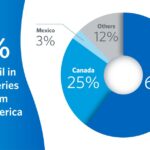Navigating airport security can be stressful, especially when it comes to understanding the rules about liquids. This guide provides a comprehensive overview of the TSA’s liquid regulations, ensuring you know exactly How Much Liquid Allowed On Plane and how to pack it correctly. We’ll cover the 3-1-1 rule, exceptions for essential items, and tips for packing liquids in both carry-on and checked luggage.
Decoding the 3-1-1 Rule: Your Liquid Allowance
The Transportation Security Administration (TSA) enforces the 3-1-1 rule for liquids in carry-on baggage. This rule limits the amount of liquid you can bring in your carry-on to ensure aviation security. But what does each number signify?
- 3: Refers to the 3.4-ounce (100 milliliters) limit per container.
- 1: Denotes that all containers must fit into one clear, quart-sized bag.
- 1: Indicates that each passenger is allowed only one quart-sized bag.
Any liquids exceeding these limitations won’t pass through security and will be discarded. Remember, TSA considers aerosols, gels, creams, and pastes as liquids. This includes items like toothpaste, hairspray, peanut butter, shampoo, soup, mascara, and mouthwash. If it can be squeezed, sprayed, or spread, it’s a liquid according to the TSA.
Exceptions to the Liquid Rule: What You Need to Know
While the 3-1-1 rule is generally strict, the TSA recognizes certain situations where passengers might need to carry more than 3.4 ounces of liquid. These exceptions typically apply to items needed during your flight or at your destination, especially if they are unavailable after the security checkpoint. Common exceptions include:
- Baby and Toddler Drinks and Food: This includes pureed pouches and other essential nutrition.
- Breast Milk and Infant Formula: Essential for infant care.
- Ice, Gel, or Freezer Packs: Used to keep breast milk, infant formula, or medically necessary items cool.
- Medical Prescriptions: Liquid, gel, or cream forms of prescribed medication.
Since 2020, passengers have been allowed to carry up to 12 ounces of hand sanitizer, but this exception is subject to change. It’s essential to declare these items to TSA officers and have them readily accessible for inspection. Labeling medications clearly can expedite the screening process. TSA officers may visually inspect, X-ray, or test the liquids for traces of explosives. While prescription medications are exempt from the 3-1-1 rule, remember that non-prescription medications still fall under it.
If you prefer to avoid X-ray screening for infant or toddler food, drinks, formula, or breast milk, inform the TSA officer. Alternative screening methods will be used, but be prepared for additional screening and potential delays.
Frozen Liquids: Understanding the Rules
The TSA makes a distinction for frozen liquids. Completely frozen liquids are not subject to the 3-1-1 rule. However, this is contingent on the substance remaining completely frozen. If the item is slushy or partially melted, it must adhere to the 3-1-1 requirements, irrespective of the amount of thawed liquid.
How Many 3.4 oz Bottles Can You Take?
So, how much liquid allowed on plane in terms of bottles? You can typically fit around seven or eight 3.4-ounce bottles into a quart-sized bag. This translates to approximately 25 liquid ounces in total.
Choosing the Right Quart-Sized Bag
While the TSA doesn’t endorse specific brands, the standard resealable quart-sized bag is approximately 7″ by 8″. Using a travel toiletry bag that approximates these dimensions is advisable. Passengers have had liquids confiscated for using bags deemed too large, even if they contained only 3.4-ounce containers. You can opt for a travel toiletry bag or a simple Ziploc bag; the key is ensuring it meets the size requirements.
Packing Liquids in Checked Luggage: What’s Allowed?
The TSA is more lenient regarding liquids in checked luggage. You can pack full-size bottles of creams, gels, drinks, and toiletry-based aerosols in your checked baggage. However, certain liquids are prohibited from both checked and carry-on luggage due to safety concerns. These include:
- Alcoholic Beverages over 70% ABV
- Aerosols that are not toiletries
- Flammable liquids
- Toxic liquids
- Bleach
- Fertilizer
- Insecticide
These liquids are strictly prohibited, and their discovery can lead to missed flights, arrest, and legal repercussions. When traveling internationally, be mindful of your destination’s regulations. For example, many Islamic countries have restrictions on alcohol, which may lead to confiscation during customs. Always check the laws of your destination country before traveling with liquids.
Conclusion: Stay Informed and Pack Smart
Understanding how much liquid allowed on plane is crucial for a smooth travel experience. By adhering to the 3-1-1 rule, being aware of exceptions, and packing prohibited items safely in checked luggage, you can avoid unnecessary delays and ensure compliance with TSA regulations. Remember, staying informed and planning ahead are key to stress-free travel.
